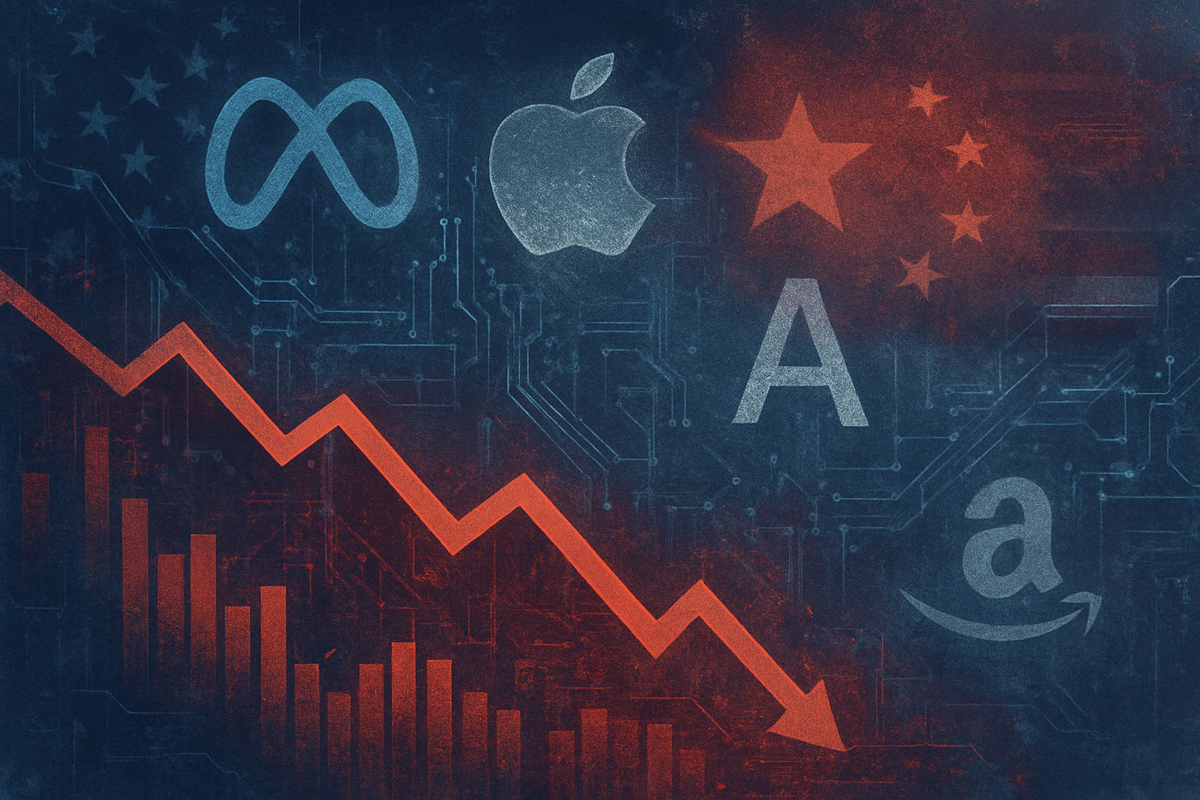
The U.S. stock market experienced a notable shift in late October 2025, with major indices showing signs of volatility as investors digested a mixed bag of big tech earnings reports and the details of a highly anticipated US-China trade truce. While earlier in the week saw indices soaring to new records on optimism, the immediate aftermath of these key events on October 30, 2025, brought a more cautious sentiment, leading to a broad market slide.
This pullback underscores a growing investor discernment, particularly regarding the profitability of massive Artificial Intelligence (AI) investments by tech giants and a "buy the rumor, sell the fact" reaction to geopolitical developments. The confluence of corporate performance and international diplomacy is shaping a complex landscape for equities as the year draws to a close.
Detailed Market Dynamics: Earnings, Truce, and Investor Scrutiny
The latter half of October 2025 proved to be a pivotal period for financial markets, characterized by both soaring optimism and subsequent caution. Leading up to October 30, the Dow Jones Industrial Average, S&P 500, and Nasdaq Composite had all achieved fresh all-time highs, fueled by expectations of a US-China trade deal and an anticipated interest rate cut by the Federal Reserve. However, this bullish momentum hit a speed bump as the market began to process concrete details from two major catalysts.
On the corporate front, the earnings season for the "Magnificent Seven" tech companies delivered a spectrum of results that prompted varied investor responses. Alphabet (NASDAQ: GOOGL) emerged as a clear winner, reporting stellar Q3 2025 results on October 29, with revenue exceeding $100 billion for the first time ($102.3 billion) and EPS of $2.87, significantly beating analyst estimates. The market rewarded this performance, with Alphabet's stock climbing, as investors saw tangible returns on its AI investments despite increased capital expenditure forecasts. Conversely, Meta Platforms (NASDAQ: META) faced a sharp decline, plummeting over 9% in after-hours trading and approximately 11% at market open on October 30. Despite a revenue beat at $51.2 billion, a substantial one-time, non-cash tax charge of $15.9 billion slashed net income by 83%, coupled with investor unease over surging AI costs and a cautious 2026 outlook. Similarly, Microsoft (NASDAQ: MSFT), despite reporting strong fiscal Q1 2026 results with robust Azure cloud growth, saw its stock dip almost 4% after hours and roughly 2% at market open. This reaction was primarily due to concerns over accelerating capital expenditure for AI infrastructure and a $3.1 billion impact on net income related to its investment in OpenAI. Apple (NASDAQ: AAPL) and Amazon (NASDAQ: AMZN) were scheduled to report their Q3 2025 earnings after market close on October 30, with analysts keenly watching iPhone 17 sales, AWS performance, and updates on their respective AI strategies.
Simultaneously, a significant geopolitical development unfolded with the announcement of a US-China trade truce on October 30. Presidents Donald Trump and Xi Jinping met in South Korea, agreeing to a deal where the U.S. would lower tariffs on Chinese goods by 10% in exchange for China's commitments on fentanyl-related chemicals, rare-earth exports, and increased purchases of U.S. soybeans. While the anticipation of this truce had driven earlier market rallies, the immediate reaction on October 30 was more subdued, following a "buy the rumor, sell the fact" pattern. Chinese shares retreated, and U.S. stock futures opened lower, suggesting that much of the positive sentiment had already been priced into the market. This agreement, while stabilizing relations, was largely seen as a de-escalation rather than a comprehensive resolution of deeper trade tensions. The Federal Reserve's cautious stance on future rate cuts, despite an immediate cut, further contributed to the market's cautious tone, with Chair Jerome Powell warning that aggressive easing was not a "foregone conclusion."
Companies in the Crosshairs: Winners and Losers from Current Trends
The recent market dynamics, shaped by big tech earnings and the US-China trade truce, have created a clear distinction between potential winners and those facing headwinds in the coming months. The immediate reactions to earnings reports highlight a new era of investor scrutiny, where significant AI investments must demonstrate a clear path to profitability rather than just growth.
Alphabet (NASDAQ: GOOGL) appears to be a clear frontrunner in this environment. Its strong Q3 2025 performance, particularly its ability to translate AI investments into tangible revenue growth, has reassured investors. The company's diverse revenue streams, including search advertising and cloud services (Google Cloud), position it well to capitalize on the increasing demand for AI-driven solutions without facing the same level of skepticism regarding expenditure. Apple (NASDAQ: AAPL), awaiting its earnings report, is expected to benefit from strong demand for its latest iPhone 17 Pro and Pro Max models, indicating continued consumer loyalty and pricing power. Its strategic approach to AI integration, often more focused on user experience rather than raw infrastructure spend, might shield it from some of the investor concerns plaguing its peers.
On the other hand, Meta Platforms (NASDAQ: META) and Microsoft (NASDAQ: MSFT) are navigating a more challenging landscape. Meta's substantial one-time tax charge and surging capital expenditure for AI and the metaverse have spooked investors, leading to a significant stock decline. The market is questioning the immediate returns on these massive investments, demanding greater clarity on future profitability. While Microsoft's core cloud business (Azure) remains robust, its accelerated AI infrastructure spending and the financial impact of its OpenAI investment have raised red flags. Investors are seeking more assurances that these enormous outlays will translate into sustainable, high-margin growth rather than just increased costs. Amazon (NASDAQ: AMZN), also yet to report, will be under intense scrutiny regarding its AWS performance and the profitability of its own substantial AI infrastructure investments. The company's ability to demonstrate efficient capital deployment and strong returns on its AI initiatives will be crucial in determining its market trajectory.
The US-China trade truce, while a positive de-escalation, offers a more generalized benefit by reducing geopolitical uncertainty. Companies with significant exposure to the Chinese market or those reliant on global supply chains, across various sectors, stand to gain from stabilized trade relations. However, the 10% tariff reduction and specific commitments from China (fentanyl, rare-earth, soybeans) suggest that the immediate direct beneficiaries are more niche, such as U.S. agricultural exporters and potentially specific manufacturing sectors that faced the previously higher tariffs. For big tech, the truce primarily provides a more stable operating environment, easing some of the broader economic headwinds, but its direct impact on their stock performance pales in comparison to their individual earnings results and AI strategies.
Wider Significance: Trends, Ripple Effects, and Historical Parallels
The recent market movements, driven by big tech earnings and the US-China trade truce, are not isolated incidents but rather significant indicators of broader industry trends and economic shifts. The heightened scrutiny on AI investment profitability, the "buy the rumor, sell the fact" dynamic of trade deals, and the cautious stance of the Federal Reserve collectively paint a picture of a market transitioning from a growth-at-all-costs mentality to one demanding demonstrable returns and stability.
This event fits squarely into the broader trend of AI's transformative, yet costly, impact on the tech sector. Companies are pouring billions into AI infrastructure, research, and development, but the market is now demanding a clearer roadmap for monetization. This could lead to a bifurcation within the tech industry: those that can effectively integrate AI into profitable products and services will thrive, while others that merely spend heavily without clear returns might face investor backlash. The ripple effects are profound; smaller AI startups will find it harder to compete with the capital expenditure of giants, potentially leading to consolidation. Partners in the AI supply chain, such as chip manufacturers and data center operators, will continue to see robust demand, but their profitability will also come under scrutiny. Furthermore, regulatory bodies worldwide are increasingly eyeing the dominance of big tech in AI, raising potential antitrust concerns and calls for greater oversight, which could impact future growth strategies and merger activities.
Historically, periods of rapid technological advancement often see initial market exuberance followed by a more discerning phase where profitability becomes paramount. The dot-com bubble of the late 1990s serves as a stark reminder, where companies with promising technologies but no clear business model eventually collapsed. While the current AI boom is fundamentally different, the investor demand for tangible returns echoes these past cycles. Similarly, US-China trade relations have historically been a major determinant of global market sentiment. While the current truce offers a temporary reprieve, the underlying strategic competition and technological rivalry between the two superpowers persist. This ongoing tension means that companies with extensive global supply chains or market exposure in both regions will need to maintain agile strategies, potentially diversifying manufacturing or market penetration to mitigate future geopolitical risks.
The cautious tone from the Federal Reserve, even after an interest rate cut, signals that monetary policy might not be as aggressively accommodative as some investors hoped. This places a greater emphasis on corporate fundamentals and less on cheap capital driving market gains. It suggests a return to more traditional valuation metrics, where earnings growth, balance sheet strength, and clear strategic vision will be rewarded over speculative bets.
What Comes Next: Navigating a Complex Future
Looking ahead, the market faces a nuanced and potentially volatile period, shaped by the evolving dynamics of big tech's AI ambitions, the delicate balance of global trade, and the Federal Reserve's monetary policy. Both short-term adjustments and long-term strategic pivots will be crucial for companies and investors alike.
In the short-term, expect continued scrutiny on upcoming tech earnings reports, particularly from Apple (NASDAQ: AAPL) and Amazon (NASDAQ: AMZN), which will provide further clues on investor sentiment regarding AI capital expenditure and profitability. Any guidance from these giants regarding their 2026 outlooks will be critical. Market volatility is likely to persist as investors re-evaluate valuations in light of mixed earnings and a less aggressively dovish Fed. The "Magnificent Seven" might see further differentiation, with companies demonstrating clear ROI on AI being rewarded, while those with opaque or highly expensive AI strategies face continued pressure. The US-China trade truce, while a positive step, is a temporary agreement; any signs of renewed tensions could quickly erode market confidence.
Long-term, tech companies will need to adapt their strategies to prioritize profitable AI implementation. This means moving beyond simply spending on AI infrastructure to demonstrating how AI directly contributes to revenue growth, cost reduction, or enhanced user engagement with clear financial benefits. Strategic pivots might involve more targeted AI investments, greater emphasis on AI-driven product innovation that commands premium pricing, or even divestment from less promising AI ventures. For companies with significant international exposure, particularly in Asia, supply chain resilience and diversification will remain paramount. The trade truce does not eliminate the need for hedging against future geopolitical risks.
Market opportunities may emerge in sectors that provide the foundational technologies for AI, such as advanced chip manufacturing and specialized data services, provided they can scale profitably. Additionally, companies that can leverage AI to create genuinely disruptive and efficient solutions in non-tech sectors (e.g., healthcare, logistics, finance) could see significant growth. Challenges include the risk of AI investment bubbles, regulatory hurdles for dominant tech players, and the ongoing talent war for AI specialists. Potential scenarios range from a continued tech-led bull market, albeit with greater selectivity, to a broader market correction if AI profitability concerns or geopolitical tensions escalate.
Comprehensive Wrap-Up: A Market at a Crossroads
The events of late October 2025 – the mixed big tech earnings and the US-China trade truce – signify a pivotal moment for the financial markets. The key takeaway is a clear shift in investor focus: the era of unbridled growth expectations for tech, particularly in AI, is giving way to a demand for demonstrable profitability and efficient capital allocation. While the overall market reached new highs, the immediate slide on October 30 underscored that even positive geopolitical news, once priced in, won't sustain rallies without strong underlying corporate fundamentals.
Moving forward, the market will likely exhibit greater selectivity, rewarding companies that can clearly articulate and execute a profitable AI strategy. The "Magnificent Seven" tech giants will continue to be market movers, but their individual performances will diverge more sharply based on their ability to manage massive AI-related capital expenditures and convert them into sustainable earnings. The trade truce, while a welcome de-escalation, serves as a reminder that geopolitical factors remain a significant, albeit volatile, component of market sentiment.
Investors should closely watch several key indicators in the coming months: the upcoming earnings reports from Apple (NASDAQ: AAPL) and Amazon (NASDAQ: AMZN), further details on the profitability and return on investment from AI initiatives across the tech sector, and any developments in US-China trade relations beyond the initial truce. The Federal Reserve's future commentary on interest rates will also be crucial. This period calls for a discerning approach, focusing on companies with strong balance sheets, clear strategic visions, and a proven ability to translate innovation into profitable growth, rather than chasing speculative trends. The market is at a crossroads, and only those companies that can effectively navigate the complexities of technological transformation and global economics will emerge as long-term winners.
This content is intended for informational purposes only and is not financial advice






